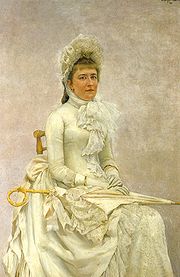Lydia Welti-Escher's Human Design Chart
3/5 Emotional Manifesting GeneratorSwiss patron of the arts, an outstanding woman of the Belle Époque in Switzerland, and one of the richest women of Switzerland in the 19th century, who established the Gottfried Keller Foundation.
Scion of the Escher vom Glas family, an old and influential Zürich family dynasty, she was the daughter of Augusta Escher-Uebel (1838–1864) and Alfred Escher (1819–1882), among others the founder of the Gotthardbahn. Lydia grew up at the country house Belvoir, built by her grandfather Heinrich Escher on the left shore of Zürichsee in the then village of Enge, as of today a district of the city of Zürich.
At the age of four years, Lydia lost her younger sister, Hedwig (1861–1862), and Lydia’s mother died in 1864. She grew into the role of the hostess and entertainer of the numerous guests of her father, among them the Swiss poet Gottfried Keller who was also a fatherly friend, along with the painter Louise Breslau. On the morning of 6 December 1882 her father Alfred Escher died on his Belvoir estate.
On 4 January 1883 Lydia married Friedrich Emil Welti, the son of the Swiss Federal Councillor (Bundesrat) Emil Welti, one of the then most powerful people in Switzerland, and former companion and later opponent of Lydia’s father.
In October 1889 Lydia and her husband moved to Florence, but shortly after, Friedrich Emil Welti went for financial reasons back to Switzerland, and left his wife in care of Karl Stauffer, a Swiss painter and Lydia’s childhood friend. Lydia and Stauffer fell in love, and fled to Rome. Lydia Welti-Escher returned to her husband, soon filing for a divorce, which was eventually granted. In a state of despondency over the loss of his love, Karl Stauffer-Bern suffered a nervous breakdown, and in January 1891, committed suicide.
After four months of internment in the public psychiatric hospital in Rome, Lydia Escher was finally brought back by her husband to Switzerland. She approved his desire of divorce and a financial agreement, which committed Lydia to a payment of 1.2 million Swiss Francs ‘compensation’ to Welti. In the ‘high society’ of Zürich, Lydia was no longer accepted, and she was ostracized as an adulteress. Therefore, she moved into a house in Genève-Champel in the late summer of 1890. There Lydia Escher finished her last goal in life, the establishment of an Arts foundation, later named Gottfried Keller Stiftung, which she devoted to her fatherly friend from her youth. Lydia Welti-Escher decided to end her life on 12 December 1891; she opened the gas tap in her villa near Geneva.
Link to Wikipedia biography
Discover More Famous People
Browse and analyze over 55,000 public figures and celebrities.
Ra Uru Hu
5/1 Manifestor
Martha Stewart
4/6 Manifestor
David Lynch
4/6 Generator
Barack Obama
6/2 Projector
Steve Jobs
6/3 Generator
Vladimir Putin
5/1 Manifestor
Kim Kardashian
3/5 Generator
Michael Jackson
1/3 Projector
Marilyn Monroe
6/2 Projector
Ariana Grande
2/4 Projector
Oprah Winfrey
2/4 Generator
Johnny Depp
2/4 ManifestorWhat is HumanDesign.ai and how does it work?
Curious what makes Lydia Welti-Escher tick? HumanDesign.ai instantly maps their exact birth data into a fully interactive clickable bodygraph chart, letting you hover or tap every center, channel, and gate for plain-language explanations. Bella, the platform’s built-in AI guide, adds context in real time, translating complex mechanics into everyday insights so you can see how Lydia Welti-Escher’s strengths, challenges, and life themes play out on-screen.
The same tools are waiting for you. Generate your own Human Design Chart in seconds, open a library of 2000+ suggested questions, and chat with Bella as often as you like to decode your design, daily transits, and even relationship dynamics.
Want to compare energies? Save unlimited charts for friends, family, or clients, then ask Bella to reveal compatibilities, composite patterns, or coaching tips, all in one conversation thread.
Start free with core features, or unlock our Personal and Pro plans for deeper dives: unlimited Q&A, celebrity chart search spanning 55,000+ public figures, white-label PDF reports, branded content generation, and a professional profile with built-in booking for practitioners. Whether you’re exploring your own potential or guiding others, HumanDesign.ai delivers an ever-expanding toolbox of AI-powered insights—no spreadsheets, no jargon, just clarity at your fingertips.
Ready to see yours? Signup for FREE today!

